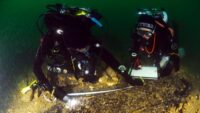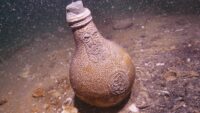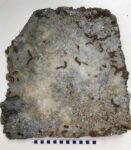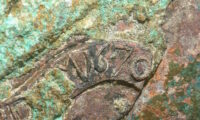 A shipwreck discovered off the coast of Eastbourne in southern England has been identified as the 17th century Dutch warship Klein Hollandia. It was built in 1656 and for the next 16 years fought in every major battle of the Second Anglo-Dutch War (1665-1667) before going down at the beginning of the Third Anglo-Dutch War.
A shipwreck discovered off the coast of Eastbourne in southern England has been identified as the 17th century Dutch warship Klein Hollandia. It was built in 1656 and for the next 16 years fought in every major battle of the Second Anglo-Dutch War (1665-1667) before going down at the beginning of the Third Anglo-Dutch War.
In 1672, the ship was part of the squadron of Admiral de Haese to escort the Smyrna fleet while sailing from the Mediterranean into the English Channel, en-route to the Netherlands. At the Isle of Wight, the squadron was attacked by an English squadron under Admiral Holmes.
A fierce battle broke out on the second day, 23 March, resulting in the Klein Hollandia being damaged severely. The commander of the ship, Jan Van Nes was killed in action. The ship was boarded and conquered by the English, but shortly after the Klein Hollandia sank with both English and Dutch sailors on board. This surprise action by the small squadron under Sir Robert Holmes and Sir Frecheville Holles contributed to the start of the Third Anglo-Dutch War.
 The wreck was first spotted in 2015 during a UK Hydrographic Office survey off the Sussex coast, but the survey data could only categorize it as an anomalous element on the seabed, not as a sunken vessel. That was confirmed four years later when a recreational diver laid eyes on the “anomaly” and reported to Historic England that it was indeed a shipwreck.
The wreck was first spotted in 2015 during a UK Hydrographic Office survey off the Sussex coast, but the survey data could only categorize it as an anomalous element on the seabed, not as a sunken vessel. That was confirmed four years later when a recreational diver laid eyes on the “anomaly” and reported to Historic England that it was indeed a shipwreck.
Dutch and British maritime archaeologists began exploring the site in 2019, finding it in good condition.  The wooden hull is mostly intact and several of its bronze cannons appear to be in excellent condition. Some of its cargo, including Italian pottery and marble tiles, were also found intact on the seabed. Microscopic examination, mineral composition and stable isotope analysis of two of the tiles that were recovered from the wreck found that they are made of marble from the famed Carrara quarries in Tuscany. They were likely destined for a wealthy home in the Netherlands.
The wooden hull is mostly intact and several of its bronze cannons appear to be in excellent condition. Some of its cargo, including Italian pottery and marble tiles, were also found intact on the seabed. Microscopic examination, mineral composition and stable isotope analysis of two of the tiles that were recovered from the wreck found that they are made of marble from the famed Carrara quarries in Tuscany. They were likely destined for a wealthy home in the Netherlands.
 Volunteers worked with the professional divers to document the wreck and to look for evidence that might identify it. One vision-impaired volunteer proved particularly helpful with the bronze cannons thanks to his tactile reading abilities. After 282 dives, archival research and tree ring analysis of the ship’s timbers helped narrow down the field and identify the ship as the Klein Hollandia.
Volunteers worked with the professional divers to document the wreck and to look for evidence that might identify it. One vision-impaired volunteer proved particularly helpful with the bronze cannons thanks to his tactile reading abilities. After 282 dives, archival research and tree ring analysis of the ship’s timbers helped narrow down the field and identify the ship as the Klein Hollandia.